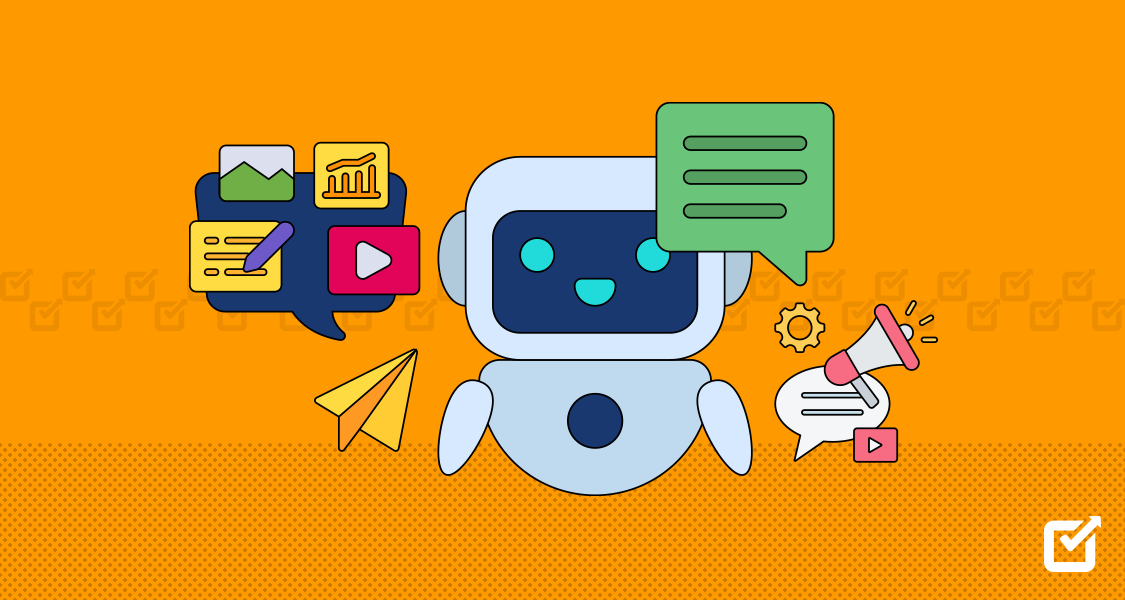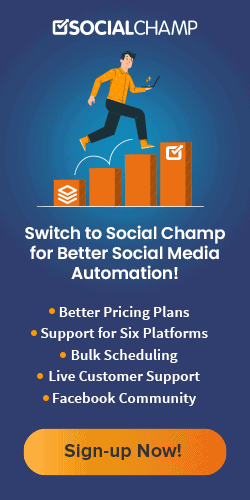Imagine entering a shopping store with the stylistic shoes to wear. You like a pair, try it out, and look around to get some assistance, but wait, there is no human entity around. No, the salesmen are not anywhere else; the reality is – the store has none.
In case you need any assistance, there are chatbots for marketing available for your service where you can ask questions, get directions, and help yourself.
Did you feel surprised while reading this? Mind it, it was just an imagination – but modern-day businesses have been manifesting this scenario lately since Artificial Intelligence and Virtual Reality have evolved into business management dynamics.
While consumers have wholeheartedly welcomed this technological revolution, social media marketing has also integrated the concept of chatbot marketing quite rapidly. You might see a social media management tool and a chatbot going hand in hand for marketing purposes. Businesses and individuals have adopted the idea and are enjoying the outcomes in the form of strengthened customer service and potential lead generation.
Hence, the concept of using chatbots for marketing has a lot in store. Let me take you in-depth into the idea and how it all works.
The Actual Narrative of a Chatbot
Is a chatbot a machine? Is there a human-like entity behind a chatbot?
Hear someone shouting the word “chatbot,” and you will find yourself wondering thoughts like the above. However, the concept is just simple.
A chatbot is a computer program or an artificial intelligence (AI) system designed to interact with humans through a chat interface. Chatbots can be either rule-based or use natural language processing (NLP) techniques to understand and interpret user inputs. They simulate conversations with users by understanding and responding to their inquiries, requests, or commands based on predefined rules, algorithms, or machine-learning models.
Some chatbots follow a set of predefined rules, known as rule-based or scripted chatbots. In contrast, others utilize machine learning algorithms, known as AI chatbots or intelligent chatbots, to learn from data and improve their responses over time. You can find chatbots on various platforms, such as messaging apps, websites, or standalone applications.
Fun Fact: Apple’s Siri, Amazon’s Alexa, and Google’s Assistant are chatbots.
Chatbots for Marketing: A Powerful Concept
Chatbots for marketing have become a dearly-welcomed concept by business owners and stakeholders. Chatbot marketing, also known as conversational marketing, is the practice of using chatbots as a tool for marketing and engaging with customers. It involves integrating chatbots into marketing strategies to facilitate personalized and interactive conversations with potential or existing customers.
Chatbots for marketing leverage the capabilities of chatbots to deliver targeted messages, gather user data, provide product recommendations, and guide users through the sales funnel. Chatbots can be deployed on various platforms, such as websites, social media, messaging apps, or dedicated chatbot platforms, to interact with users in real time.
In recent times, chatbot marketing has proven itself to be a valuable tactic for business benefits in numerous ways. According to Statista, 57 percent of B2B marketers in the United States used chatbots in their demand generation programs to understand their audience better.
Most commonly, chatbots for marketing are integrated into messaging apps: Facebook Messenger, Slack, WeChat, and more, for the purpose of providing instant customer support. These chatbots at service allow businesses to be active and responsive 24/7 creating a bigger impact on their audience base.
Advantages of Chatbot Marketing
It is possible that you assume the process of integrating a chatbot marketing strategy to be chaotic and time-consuming. However, it is all of good worth. To convince you more, below mentioned are a few advantages of chatbot marketing for you.
Chatbots Are Trendy
Since ChatGPT has shaken the dynamics of the technical landscape, every business giant has taken the initiative to introduce a similar AI model. Hence, using chatbots for marketing is a popular and modern way to engage with customers and attract them better. By incorporating chatbots into your marketing strategy, you can showcase your brand as innovative and up-to-date with the latest technology trends, attracting tech-savvy customers.
Chatbots Save Time & Effort
Why invest time in something an integrated bot can easily do?
Chatbots can handle multiple conversations simultaneously and provide instant responses. They can automate routine tasks, answer frequently asked questions, and assist users 24/7 without requiring human intervention. This saves time and effort for both customers and your business. Hence, you can take over the responsibility of any other important task while leaving the rest to chatbots for sales and marketing.
Chatbots Guide Users Better
You cannot expect a chatbot to be rude to your customers out of frustration. Instead, chatbots for marketing can serve as virtual assistants, guiding users through the sales process, providing product recommendations, or helping them find the information they need calmly and composedly.
In addition, chatbots can also offer personalized guidance and improve the overall user experience with their interactive and conversational nature.
Chatbots Automate Conversations
You can automate all the conversations by letting chatbots handle initial customer interactions, gather relevant information, and provide essential support. This provides freedom to the human resources to focus on more complex or specialized tasks, increasing productivity and cost savings.
A notable example of this advantage is the usage of chatbots for email marketing. Integrate a chatbot with your email or customer relationship management system CRM), and your email responses will be delivered to the customers in no time, making your marketing workflows faster.
Chatbots Generate Leads Effectively
Using chatbots for sales and marketing can help you improve lead generation by engaging with website visitors, qualifying leads, and collecting contact information. Businesses can gather valuable lead data more effectively by using interactive forms or surveys within the chatbot interface.
Create AI-Enabled Content With Social Champ!
Try Champ AI Suite and craft engaging content pieces, generate images, and analyze the tone of your post with Sentiment Analysis.
Chatbot Marketing Examples
Now that you are well aware of how chatbots for marketing play a vital role in elevating a business’s profit and value, let me give you a few examples of how organizations are using chatbots.
Eddy Travels
Eddy Travels is an AI travel assistant that facilitates users with the best and most affordable flights all across the globe. The platform has an integrated AI chatbot that talks to the user, asks for initial information, and provides them with their requested flights booked. Moreover, the chatbot also assists you with the cheapest hotels, apartments, tours and activities, airport shuttle, and a lot more.
Here is an example of how the chatbot works.

Estee Lauder
Another notable mention of the usage of a chatbot for marketing is within the market of beauty and cosmetics. Estee Lauder is a renowned beauty brand that deals with skincare, cosmetics, and fragrances. They have a chatbot integrated into their Instagram account that facilitates users instantly. Here is an example.

Bath & Body Works
Bath and Body Works is a renowned brand for the best home fragrance, gifts, body and bath products. Their website has a chatbot named Violet that guides customers about order support, delivery, rewards, promos, returns, and exchanges. The chatbot serves as a very optimized customer support service. Here is an example.

H&M
The following featured example in our list of fancy chatbots for marketing is the H&M chatbot. H&M, a popular fashion retailer, H&M has incorporated a chatbot named “H&M Assistant” on its website and app. The chatbot offers style inspiration, assists with product searches, provides sizing advice, and answers customer queries. It also offers outfit suggestions and helps users find items similar to their preferred styles.

Sephora
Sephora, a well-known cosmetics and beauty retailer, has implemented a chatbot on its website and mobile app. The chatbot assists customers with product recommendations, makeup tips, and answers to frequently asked questions. It can also help users find nearby stores, book appointments, and provide personalized beauty advice.

Hence, these examples imply that chatbots for marketing are a growing trend. Businesses and industries are introducing the exciting addition of an exclusive chatbot for their business, and the consumers are welcoming the gesture. Hence, there is definite room for ample opportunities related to the usage of chatbots for human service and development.
Related Article: 34 Best Social Media Marketing Tools in 2025!
10 Tips for Making the Best Use of Chatbot Marketing
Using Chatbots for marketing can be critical. You might feel overwhelmed with the pressure of using your chatbot best. No need to wander directionless as here I am listing down a few tips that can help you use your chatbot to the maximum extent.
Understand Your Audience Before Choosing the Chatbot
Do not train your chatbot without conducting sufficient research on the audience demographics you usually target. Understand your target audience’s preferences, needs, and communication preferences. This will help you to select or design a chatbot that aligns with their expectations and delivers a personalized experience.
Design an Intuitive User Experience
Chatbots do not have a say of their own. They act as instructed. Hence, pay good attention to the ease of use of your chatbot. Create a chatbot with a user-friendly and intuitive interface. Ensure that it is easy to navigate, understands user inputs accurately, and provides clear and concise responses. A well-designed user experience will enhance engagement and encourage users to interact with your chatbot.
Train Your Bot According to the FAQs of Your Brand
Get feedback from your customer service representatives, marketing team, and community handlers, and jot down the frequent queries. Look for the conversations that can lead the customer through the sales funnel. Train your bot according to the reviews and optimize its performance.
Personalize Interactions
Leverage user data and preferences to personalize chatbot interactions. Tailor responses, recommendations, and offers are based on individual user behavior, demographics, or previous interactions. Personalization enhances the user experience and helps build a stronger connection with your audience. Remember, the more personalized the response, the more your customer feels valued.
Assign a Human to Take Over Critical Queries
If your chatbot encounters a user query or scenario it cannot handle, ensure a seamless transition to human support. Implement a smooth handover process, where the chatbot can transfer the conversation to a human agent without causing frustration or confusion for the user. You can train the chatbot to provide an initial response to the customer and then forward the query to any manager to deal with it.
Design According to Mobile Devices
Optimize your chatbot for mobile devices, considering the smaller screen size and different interaction patterns. Make sure the chatbot interface is responsive, visually appealing, and functions well on mobile devices to cater to users who access your chatbot through smartphones or tablets.
Monitor and Analyze Consistently
Chatbots for marketing can be erroneous and have the tendency to malfunction. Continuously monitor the performance of your chatbot and analyze user interactions and feedback. Regularly review chat logs and track metrics such as engagement rates, conversion rates, and user satisfaction to identify areas for improvement and refine your chatbot’s capabilities.
Keep a Human Aspect in the Messages
Even though chatbots are automated, it’s essential to maintain a human touch in the conversation. Use a conversational tone, inject empathy and personality into responses, and avoid sounding too robotic. You can add up emojis to keep the essence of your chatbot’s message alive. Striking the right balance between automation and a human touch will make chatbot interactions more engaging and natural.
Promote Your Chatbot
Users all across the world are showing interest in conversing with chatbots and buying through them. Hence, you should actively promote your chatbot to ensure users are aware of its existence and benefits. Incorporate call-to-actions on your website, social media profiles, and marketing materials to encourage users to interact with the chatbot. Highlight the value and convenience it provides to entice users to engage.
Train Your Chatbot Continuously
Make sure the journey of learning never ends for your chatbot. Since the trends within social media marketing keep evolving, regularly update and train your chatbot to improve its performance. Incorporate user feedback, analyze conversation logs, and make adjustments to enhance its accuracy, expand its knowledge base, and ensure it stays up-to-date with your industry’s latest information and trends.
Social Champ’s Champ AI Suite
Jumping on the bandwagon of the cutting-edge technology of Artificial Intelligence, Social Champ has recently introduced its feature, “Champ AI Suite,” exclusively powered by ChatGPT. It consists of a premium feature, including AI Content Wizard, that allows you to generate content copies with just a few words aided to the tool, and boom; your task is done in a few minutes.
In case your next Facebook post requires an aesthetic design, and you have no one to do so, then AI Imaginator can be your shining armor. Give the tool a few instructions on how you want the image to look, and a high-quality image will be efficiently created.
Lastly, shape a perfect social media for business marketing strategy hitting the right emotions with each effort with the help of the Sentiment Analysis feature. Recognize the emotions within the text: positive, negative, and neutral. Download PDF reports of the content analysis for future sentiment detection.
Related Article: GPT 3 Chatbot: A Magic Tool to Supersede Human Workforce & More
Adopt, Evolve, & Grow!
Summing up the discussion, it is pretty evident that as technology continues to advance, chatbot marketing will evolve further, incorporating natural language processing, artificial intelligence, and machine learning capabilities. This will enable chatbots to become even more intelligent, empathetic, and capable of handling sophisticated tasks.
Hence, companies can easily elevate their marketing efforts and foster meaningful connections with their audience. Ultimately, this will lead to driving business growth in an increasingly digital world by embracing this innovative technology and making the best use of it.





















